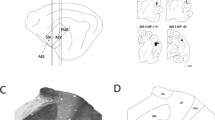Abstract
Studies of the characteristics of baseline spike activity in the central and basolateral nuclei of the amygdala demonstrated significant differences between these nuclei. Lesioning of the medial cervical nucleus, which is one of the sources of ascending serotoninergic projections of the forebrain, led to marked and generally reciprocal changes in the spike activity of the amygdalar nuclei studied. It is suggested that serotoninergic afferentation from the medial cervical nucleus modulates the activity of amygdalar nuclei with different functional assignments.
Similar content being viewed by others
REFERENCES
Yu. A. Fadeev, Cerebral Cortex Neurons in the Systems Organization of Behavior [in Russian], Moscow (1998).
M. V. Khanbabyan, N. A. Saakyan, and R. Sh. Sarkisyan, “Effects of immobilization stress on the baseline activity of locus ceruleus neurons,” Neirofiziologiya, 33, No.3, 179–183 (2001).
S. A. Chepurnov and N. E. Chepurnova, Neuropeptides and the Amygdala [in Russian], Moscow State University Press, Moscow 185
F. Abad-Alegria, “Estereotaxis troncoencephalica,” Trab. Inst. Cajal Invest. Biol., 63, No.1, 193–224 (1971).
G. Aghajanian, H. Heigler, and J. Bennet, “Amine receptors in CNS. III. 5-Hydroxytryptamine,” Handbook of Psychopharmacol., No. 6, 63–96 (1975).
D. Albe-Fessard, F. Stutinsky, and S. Libouban, Atlas Stereotaxique du Diencephale du Rat Blanc, Editi. De Centre Nat. de la Recherche, Paris (1966).
N. Anden, H. Corrodi, K. Fuxse, and T. Hokfelt, “Evidence for a central 5-hydroxytryptamine receptor stimulation by lysergic acid diethylamide,” Brit. J. Pharmacol., 34, 1–7 (1968).
C. Berridge and E. Abercrombie, “Relationship between locus coeruleus discharge rates and rates of norepinephrine release within neocortex as assessed by in vivo microdialysis,” Neurosci., 93, No.4, 1263–1670 (1999).
F. Bloom, B. Hoffer, and C. Nelson, “The physiology and pharmacology of serotonin mediated synapses,” in: Serotonin and Behavior, Academic Press, New York (1973), pp. 249–261.
W. Burke, D. Parke, and H. Chung, “Evidence for decreased transport of tryptophan hydroxylase in Alzheimer's disease,” Brain Res., 537, 83–87 (1990).
K. Chung, M. Martinez, and J. Herbert, “C-fos expression behavioral, endocrine and autonomic responses to acute social stress in male rats after chronic restraint: modulation by serotonin,” Neurosci., 95, No.2, 453–463 (1999).
K. Fuxe, “Evidence for the existence of monoamine neurons in the central nervous system,” Acta Physiol. Scand., Supplement 24764, 39–85 (1965).
P. Gloor, “Amygdala,” in: Handbook of Physiology, Plenum Press, Washington (1972), Vol. 1.
H. Goldstein, A. Rasmussen, B. Bunney, and R. Roth, “Role of the amygdala in the coordination of behavioral, neuroendocrine and cortical monoamine responses to psychological stress in the rat,” J. Neurosci., 16, 4787–4798 (1996).
E. Gorea and J. Adrien, “Serotoninergic regulation of noradrenergic coerulean neurons: electrophysiological evidence for the involvement of 5-HT (2) receptors,” Eur. J. Pharmacol., 154, No.3, 285–291 (1988).
F. Graeff, F. Guimaraes, T. Andrade, and J. Deakin, “Role of 5-HT in stress, anxiety and depression,” Pharmacol. Biochem. Behav., No. 54, 129–141 (1996).
T. Gray, “Limbic and neurotransmitter as modulators of autonomic and neuroendocrine responses to stress,” in: Stress: Neurobiology. Neuroendocrinology, M. R. Brow and G. F. Koob (eds.), Dekker, New York (1991), pp, 79–89.
H. Haigler and G. Aghajanian, “Lysergic acid diethylamide and serotonin: A comparison of effects on serotonergic neurons and neurons receiving a serotonergic input,” Pharmacol. Exptl. Ther., 188, 688–699 (1974).
H. Kawahara, M. Yoshida, H. Yokoo, M. Nishi, and M. Tanaka, “Psychological stress increases serotonin release in the rat amygdala and prefrontal cortex assessed by in vivo microdialysis,” Neurosci. Lett., 162, 81–84 (1993).
J. Kim, R. Rison, and M. Franselow, “Effect of amygdala, hippocampus and periaqueductal gray lesions on short-and long-term contextual fears,” Behav. Neurosci., 107, 1093–1098 (1993).
K. Livingston and O. Hornykiwich (eds.), Limbic Mechanisms, Plenum Press, New York, London (1978).
T. Ono, “Amygdalar role in emotion and learning,” in: Fourth IBRO World Congress of Neuroscience, Kyoto, Japan (1995).
E. Redgate, “ACTH release evoked by electrical stimulation of brain stem and limbic system sites in the cat,” Endocrinology, 86, 806–823 (1970).
Ch. Sinton and S. Fallon, “Electrophysiological evidence for a functional differentiation between subtypes of the 5-HT receptor,” Eur. J. Pharmacol., 157, No.2–3, 173–181 (1988).
J. Spourse and G. Aghajanian, “Electrophysiological responses of serotonin dorsal raphe neurons to 5-HT1A and 5-HT1B agonists,” Synapse, 1, No.1, 3–9 (1987).
B. Svensson, B. Bunney, and G. Aghajanian, “Inhibition of both noradrenergic and serotonergic neurons in brain by the α-adrenergic agonist clonidine,” Brain Res., 92, 291–306 (1975).
U. Ungerstedt, “Stereotaxic mapping of the monoamine pathways in the rat brain,” Acta Physiol. Scand., 367,Supplement, 1–48 (1971).
A. Webb and D. Burns, “The effect of changing levels of arousal on the spontaneous activity of the neurons in the cerebellar cortex of the unrestrained cat,” Exptl. Brain Res., 23,Supplement, 215–219 (1975).
T. Yamamoto and A. Hirano, “Nucleus raphe dorsalis in the Alzheimer's disease: neurofibrillary tangles and loss of the large neurons,” Ann. Neurol., 17, 573–577 (1985).
Author information
Authors and Affiliations
Additional information
__________
Translated from Zhurnal Vysshei Nervnoi Deyatel'nosti imeni I. P. Pavlova, Vol. 54, No. 5, pp. 698–704, September–October, 2004.
Rights and permissions
About this article
Cite this article
Khanbabyan, M.V., Kirakosyan, M.P., Sarkisyan, R.S. et al. Effects of Lesioning of the Medial Cervical Nucleus on the Baseline Spike Activity of Neurons in the Central and Basolateral Nuclei of the Amygdala. Neurosci Behav Physiol 36, 93–99 (2006). https://doi.org/10.1007/s11055-005-0166-2
Received:
Accepted:
Issue Date:
DOI: https://doi.org/10.1007/s11055-005-0166-2




